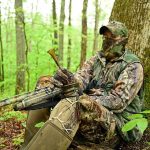Photo courtesy of the West Virginia Department of Commerce.
By: Samantha Smith | Posted: May 15, 2018 | Source: WVDNR
 SOUTH CHARLESTON, W.Va. — The Division of Natural Resources (DNR) reminds residents that feeding black bears is a violation of state law as well as a misguided disservice to our state animal, according to Colin Carpenter, black bear project leader for the DNR Wildlife Resources Section.
SOUTH CHARLESTON, W.Va. — The Division of Natural Resources (DNR) reminds residents that feeding black bears is a violation of state law as well as a misguided disservice to our state animal, according to Colin Carpenter, black bear project leader for the DNR Wildlife Resources Section.
“It is understandable that some people will set out food to get a closer look at this often-secretive animal,” Carpenter said. “However, these actions may lead to the destruction of the bear. Bear movements are tied to food sources. Bears that roam in and around residential areas in search of food are less likely to stay if they do not find anything to eat. The key to avoiding human-bear conflicts is to remove or secure food attractants before a bear finds them.
“This year, we want to get the word out about human-bear conflicts before bears show up in your neighborhood,” Carpenter said. “The peak of nuisance bear activity in West Virginia occurs during May. However, bears begin leaving their dens in mid-March, and nuisance complaints begin coming in around April 1.”
Capturing and moving bears that have become accustomed to humans is a costly and often ineffective way of addressing the problem, especially when faced with the possibility of moving a problem bear from one area to another. That is why wildlife agencies around the country tell people that a “fed bear is a dead bear.”
Bear populations have increased in both number and distribution in the past 20 years. Bears are now found in areas where they have been absent for decades and have been reported in all 55 counties. In 2015, bears were harvested in 48 of West Virginia’s 55 counties. There is simply nowhere to move bears that have become a problem, according to Carpenter.
Feeding of any wildlife should be avoided for many reasons, including, but not limited to, disease transmission, increased predation, habitat destruction around the feeding site, ethical concerns and the animal’s overall health.








